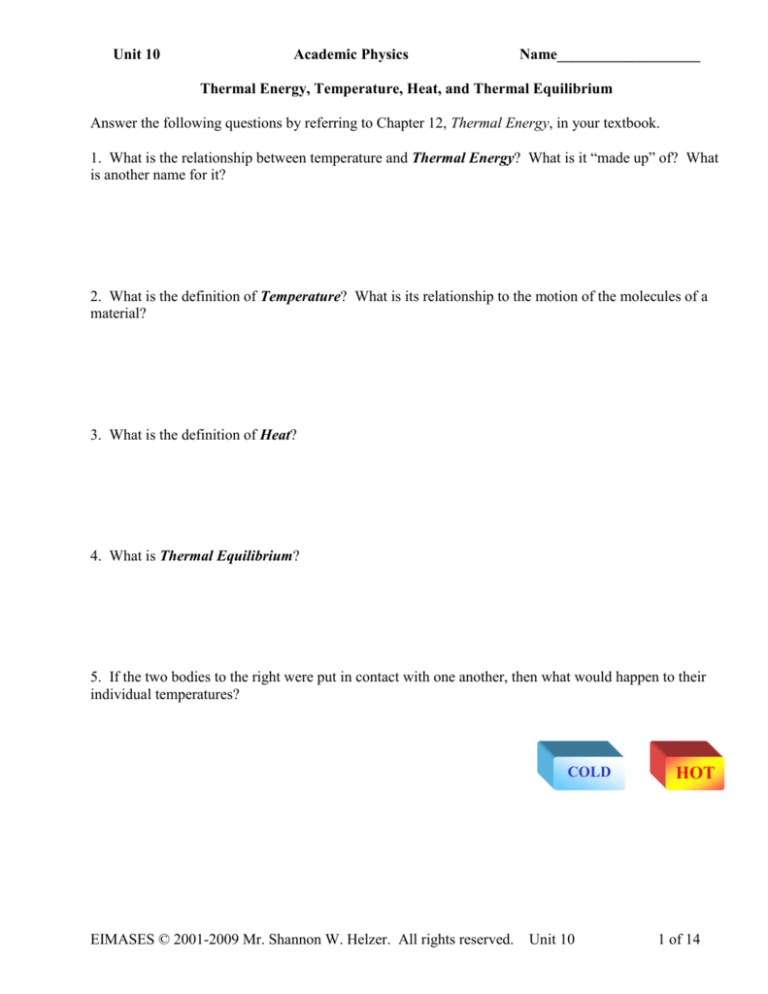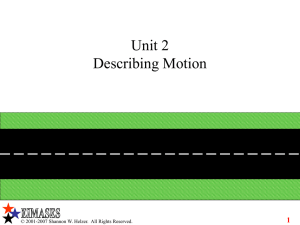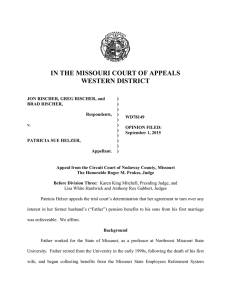
Unit 10
Academic Physics
Name___________________
Thermal Energy, Temperature, Heat, and Thermal Equilibrium
Answer the following questions by referring to Chapter 12, Thermal Energy, in your textbook.
1. What is the relationship between temperature and Thermal Energy? What is it “made up” of? What
is another name for it?
2. What is the definition of Temperature? What is its relationship to the motion of the molecules of a
material?
3. What is the definition of Heat?
4. What is Thermal Equilibrium?
5. If the two bodies to the right were put in contact with one another, then what would happen to their
individual temperatures?
COLD
EIMASES © 2001-2009 Mr. Shannon W. Helzer. All rights reserved.
Unit 10
HOT
1 of 14
Temperature Scales: Fahrenheit, Celsius, and Kelvin.
Answer the following questions by referring to Chapter 12, Thermal Energy, in
your textbook.
C
F
6. There are three primary temperature scales. The one we are most familiar with
in the United States is the Fahrenheit Temperature Scale.
a. What is the freezing point of water on this scale? ____________
b. The boiling point of water? ________________
c. What is your body temperature (average)? _________________
100
212
0
32
-40
-40
7. There are two additional temperature scales used in the scientific community.
Name one of these scales. ___________________________
a. What is the freezing point of water on this scale? ____________
b. The boiling point of water? ________________
c. What is your body temperature (average)? _________________
8. What is the remaining temperature scale used in the scientific community.
_____________________
a. What is the freezing point of water on this scale? ____________
b. The boiling point of water? ________________
c. What is your body temperature (average)? _________________
9. Temperature is the sum of the _____________ _______________ _______________ of the
molecules (or particles) of a body.
When you have different scales used in different parts of the world, it is often necessary to
convert from one scale to another. For instance if you wish to convert a temperature given in Fahrenheit
into a temperature in Celsius, then you would apply the conversion equation below.
9
TF TC 32
5
10. Rearrange this equation in order to find a Celsius temperature when given a Fahrenheit.
EIMASES © 2001-2009 Mr. Shannon W. Helzer. All rights reserved.
Unit 10
2 of 14
11. What is the equation used to convert a temperature from Celsius to Kelvin?
12. Convert 23.5C to both its Kelvin and Fahrenheit equivalents.
13. Convert 72F to both its Kelvin and Celsius equivalents.
14. Convert 100K to both its Fahrenheit and Celsius equivalents.
EIMASES © 2001-2009 Mr. Shannon W. Helzer. All rights reserved.
Unit 10
3 of 14
Calorimetry & Specific Heat
15. A calorimeter contains 500.0 g of water (C = 4180 J/kg K) at 73.8C. 150.0 g of
copper (C = 385 J/kg K) at 0.0C is added to the water. Recalling that heat lost is
equal to the heat gained in a system, answer the following questions.
a. Given that a calorimeter cup prevents the loss of energy to the outside
environment, what body(ies) make up the “system” in this problem?
b. Which body looses energy? Why?
c. Which body gains energy? Why?
d. What is the final temperature of the system?
Q mCT mCT2 T1
Qlost Qgained
9
TF TC 32
5
EIMASES © 2001-2009 Mr. Shannon W. Helzer. All rights reserved.
Unit 10
4 of 14
16. 1500.0 g of water (C = 4180 J/kg K) at 99.0C is dumped into an
aluminum coffee can (m = 150.0 g, C = 903.0 J/kg K) at room temperature
(37C). A 250.0 g lead weight (C = 130.0 J/kg K) at 10.0C is also
dropped into the water. Recalling that heat lost is equal to the heat gained
in a system, answer the following questions.
a. What body(ies) make up the “system” in this problem?
b. Which body(ies) looses energy? Why?
c. Which body(ies) gains energy? Why?
d. Given that a 1200.0 J of energy is lost to the outside environment, what is the final temperature of the
system?
Q mCT mCT2 T1
Qlost Qgained
9
TF TC 32
5
EIMASES © 2001-2009 Mr. Shannon W. Helzer. All rights reserved.
Unit 10
5 of 14
Heat Transfer Types
Label the three pictures below according to the type of heat transfer (convection, radiation, or
conduction) depicted.
17.
18.
19.
Sun
20. Which heat transfer mechanism requires a liquid medium (air, steam, water,…) in order to transfer
energy?
21. Which heat transfer mechanism requires a solid medium in order to transfer energy?
22. Which heat transfer mechanism requires a no medium whatsoever in order to transfer energy?
EIMASES © 2001-2009 Mr. Shannon W. Helzer. All rights reserved.
Unit 10
6 of 14
A iron pan full of water is placed on a stove as shown in the figure to
the right. The mass of the water is 3.5 kg (C = 4180 J/kg C), and the
mass of the iron pan is 3.5 kg (C = 450.0 J/kgC). The initial
temperature of both the pot and the water is 18C. They are heated to
90C. Answer the questions below.
23. How much heat transferred from the burner to the water in the
pan?
24. How much heat transferred from the burner to iron pan?
25. What type of heat transferred occurred in heating the water inside the iron pan? ________________
26. Suppose you put your hand in the steam above the pan. You would feel “hotness.” What type of
energy transfer carried this heat to your hand? Explain your answer.
____________________________________________________________________________________
____________________________________________________________________________________
____________________________________________________________________________________
____________________________________________________________________________________
27. Suppose you were standing across the room and could feel some heat coming from the pan. What
type of energy transfer carried this heat to you? Explain your answer.
____________________________________________________________________________________
____________________________________________________________________________________
____________________________________________________________________________________
____________________________________________________________________________________
EIMASES © 2001-2009 Mr. Shannon W. Helzer. All rights reserved.
Unit 10
7 of 14
Thermal Expansion & Heat Transfer Types
9
TF TC 32
5
Q mcT
28. With few exceptions, all forms of matter __________________ when they are heated and
_______________ when they are cooled.
29. Water is an exception to this rule. Consider the following phases of water and state whether they
will contract or expand as a result of the indicated changes in their temperatures.
a. Water initially at 10C that cools to 4C will
Expand
Contract
b. Water initially at 4C that cools to 0C will
Expand
Contract
c. Water initially at 0C that changes to ice at 0C will
Expand
Contract
d. Ice initially at 0C that changes to ice at –10.0C will
Expand
Contract
e. Steam at 115C that warms to 105C will
Expand
Contract
30. At what temperature on the Celsius Temperature Scale does H2O have its maximum density?
Convert this temperature to a Fahrenheit temperature.
TC = _______________
TF = _______________
31. What is a bimetallic strip? _________________________________________________________
____________________________________________________________________________________
32. What common household device utilizes a bimetallic strip? ________________________________
33. What is the definition of Heat?
____________________________________________________________________________________
____________________________________________________________________________________
34. Temperature is the sum of the _____________ _______________ _______________ of the
molecules (or particles) of a body.
EIMASES © 2001-2009 Mr. Shannon W. Helzer. All rights reserved.
Unit 10
8 of 14
When a bimetallic strip is manufactured for use in thermostats, the strips of metal are initially attached at
room temperature. As a result, neither strip will flex at room temperature. When the combined strips
are either heated or cooled, one strip flexes more than the other. Given the fact that brass contracts more
than iron when cooled and expands more than iron when warmed, answer the questions below.
Brass
Iron
35. Which figure above depicts the bimetallic strip when exposed to hot temperatures above room
temperature?
Left
Middle
Right
36. Which figure above depicts the bimetallic strip when exposed to room temperature?
Left
Middle
Right
37. Which figure above depicts the bimetallic strip when exposed to cold temperatures below room
temperature?
Left
Middle
Right
A block of Brass (m = 2.5 kg, C = 376.0 J/kgC) is placed onto a block of
iron (m = 4.5 kg, C = 450.0 J/kgC) as shown. Answer the questions below
based on this scenario.
Brass
Iron
38. When the two blocks are touching each other, they are said to be in
_____________________ contact with each other.
39. What is the relationship between the final temperatures of both of these blocks?
____________________________________________________________________________________
40. This relationship is known as ______________________ __________________.
41. ______________ is energy being transferred from a ___________________ body to a cold body.
42. If the iron block drops from 85C to 62C, then how much heat is transferred to the brass block?
43. Given the amount of heat transferred from the hot body to the cold body, calculate the temperature
increase experienced by the cold body.
EIMASES © 2001-2009 Mr. Shannon W. Helzer. All rights reserved.
Unit 10
9 of 14
An iron pan full of water is placed on a stove as shown in the figure to
the right. The mass of the water is 3.5 kg (C = 4180 J/kg C), and the
mass of the iron pan is 2.2 kg (C = 450.0 J/kgC). The initial
temperature of both the pot and the pan is 18C. They are heated to
90C. Answer the questions below.
44. How much heat transferred from the burner to the water in the
pan?
45. How much heat transferred from the burner to iron pan?
46. What type of heat transferred occurred in heating the water inside the iron pan? ________________
47. Suppose you put your hand in the steam above the pan. You would feel “hotness.” What type of
energy transfer carried this heat to your hand? Explain your answer.
____________________________________________________________________________________
____________________________________________________________________________________
EIMASES © 2001-2009 Mr. Shannon W. Helzer. All rights reserved.
Unit 10
10 of 14
Heat Transfer Between More than Two Bodies
9
TF TC 32
5
Q mcT
48. Hot coffee at 100.0 C (m = 200.0 g) is poured
into a glass coffee cup at 44.0 C (m = 175.0 g). The
coffee is stirred by a silver spoon taken from the
refrigerator at 5.2 C (m = 15.0 g). Given that coffee
is mostly water, determine the final temperature of
the mixture.
J
kg C
J
CGlass 840
kg C
J
CSilver 230
kg C
CW ater 4186
EIMASES © 2001-2009 Mr. Shannon W. Helzer. All rights reserved.
Unit 10
11 of 14
98.6 °C
0.6 °C
23.3 °C
49. 250.0 g of water at 98.6 C and 300.0 g of water at 0.6 C are dumped into a 2.5 kg iron skillet at
23.3 C. Determine the final temperature of the mixture.
EIMASES © 2001-2009 Mr. Shannon W. Helzer. All rights reserved.
Unit 10
12 of 14
9
TF TC 32
5
Q mcT
50. Using the formula below, derive an expression to determine TC when given the value of TF.
Calculate TC when TF = 106.0 F.
9
TF TC 32
5
51. A large Iron nut (m = 0.25 kg, T1 = 67.2 C) is dropped into an
insulated container containing water (m = 2.2 kg, T1 = 55.0 C). What is
the final temperature of the water in the insulated container?
J
kg C
J
CGlass 840
kg C
J
CSilver 230
kg C
J
C Iron 450
kg C
J
C Brass 376
kg C
CW ater 4186
EIMASES © 2001-2009 Mr. Shannon W. Helzer. All rights reserved.
Unit 10
13 of 14
52. A rare and very valuable silver coin (m =
0.30 kg, T1 = 12.2 C) is gripped by a pair of
iron tweezers (m = 0.10 kg, T1 = 45.0 C).
Given that 1000.0 J of energy is lost to the
outside environment, calculate the final
temperature of the most precious coin.
EIMASES © 2001-2009 Mr. Shannon W. Helzer. All rights reserved.
Unit 10
14 of 14







